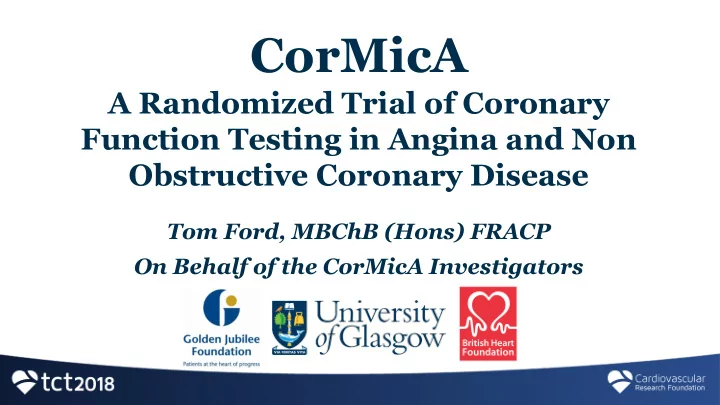

CorMicA A Randomized Trial of Coronary Function Testing in Angina and Non Obstructive Coronary Disease Tom Ford, MBChB (Hons) FRACP On Behalf of the CorMicA Investigators
Disclosure Statement of Financial Interest NIL TO DECLARE I, Tom Ford DO NOT have a financial interest/arrangement or affiliation with one or more organizations that could be perceived as a real or apparent conflict of interest in the context of the subject of this presentation.
Background 1. Ischemia without obstructive CAD - common 2. Invasive diagnostic tests are available 3. Practice guideline recommendations for therapy Ö (ESC 2013) 4. No randomized trials 5. No adoption in the clinic 6. Patient outcomes sub-optimal.
Interventional Diagnostic Procedure (IDP) IV adenosine IC Acetylcholine Epicardial Fractional Flow Acetylcholine Artery Reserve (FFR) (ACh) Bolus Prearteriolar Index of Coronary Flow Microcirculatory ACh infusion Reserve (CFR) Resistance (IMR) (Microvascular spasm) Coronary Microcirculation Arteriolar Capillaries & Venules Ford TJ, et al. Heart 2017;0:1–9.
Invasive Diagnosis with Stratified Medicine Microvascular Angina • Guideline directed therapy – e.g. Betablocker & Lifestyle Vasospastic Angina • Guideline directed therapy – e.g. CCB & Lifestyle Non-Cardiac (Normal Function) • Cease antianginal therapy +/- non-cardiac Ix
Hypothesis Stratified medicine guided by an Interventional Diagnostic Procedure (IDP) improves angina in patients without obstructive CAD
Eligibility Criteria • Age ≥18 years • Angina (Rose questionnaire) – Definite or Probable • Clinically-indicated invasive coronary angiography • Written, informed consent
CorMicA Trial Design Primary Endpoint = Angina Severity (SAQSS) Standard Angiogram 6 Months Baseline Care (Day 0) Diagnostic procedure No • SAQ Randomise Stratified Therapy, n=75 Obstructive Two Large • Consent CAD Regional • EQ-5D Hospitals • Record (Pop n 2.5m) DS <50% • TSQM9 Treatment/ FFR >0.8 • BIPQ Diagnosis • PHQ4 Referred for • SAQ Invasive Coronary • EQ-5D-5L Blind, Sham Procedure Angiogram • TSQM9 • BIPQ Standard Care , n=76 • PHQ4
Primary Endpoint (6 months vs. baseline) • Seattle Angina Questionnaire – Summary Score (SAQSS) ¡ Between group difference ¡ Regression model, adjust for the baseline score • Blinded outcome assessment • Blinded statistical analysis • Independent Clinical Trials Unit
Sample Size • Effect size of 9 units in SAQ Summary Score • 80% power • Standard deviation, 19 units • 140 randomized patients
Baseline Characteristics Control Intervention n = 76 n = 75 Definite Angina 42 (55%) 55 (73%) Probable Angina 34 (45%) 20 (27%) Non-Anginal 0 0 SAQ Summary Score 49.0 (17.2) 52.6 (18.9)
Baseline Characteristics Control (N=76) Intervention (N=75) Age 60 [53, 68] 62 [54, 69] Female 58 (76%) 53 (71%) BMI [Q1, Q3] 30 [26, 34] 30 [26, 35] Current Smoker 14 (18%) 13 (17%) Diabetes Mellitus 15 (20%) 14 (19%) Predicted 10-year CHD risk* 18% [10, 28] 19% [12, 39] * ASSIGN score
Primary Endpoint – 6 month SAQ Change Between-Group Difference 11.7 Units 14.5 Units 9.3 Units 95% CI, 5.0 to 18.4 95% CI, 7.3 to 21.7 (95% CI, 0.5 to 18.1) P=0.001 P<0.001 P=0.040 15 10 SAQ Units Control 5 Intervention 0 Summary Score Physical Limitation Angina Frequency -5
Secondary Endpoints – Health Status Intervention 95% CI P-Value Effect Quality of Life (EQ5D-5L): Index Score 0.1 0.01 – 0.18 0.024 VAS score 14.54 7.77 – 21.31 <0.001 Treatment satisfaction: 2.37 – 19.09 Effectiveness 10.73 0.013 7.30 – 21.37 Convenience 14.34 <0.001 7.28 – 25.66 Global satisfaction 16.47 0.001
Secondary Endpoints – Post Randomization Diagnostic/Clinical Utility 100% 80% 60% All, 40% P<0.001 20% 0% Diagnostic Change angina Changed Missed Certainty therapy to treat Diagnosis Diagnosis (MVA/VSA) MVA/VSA Control 0% 18% 36% 30% Intervention 52% 83% 3% 87%
Safety No Procedural SAE MACCE at 6 months • Self-limiting AF (5%), • 2 (2.6%), both groups sinus at discharge • 4 / 151 (2.6%) • Bradycardia during ACh expected physiological response
Conclusions 1. CorMicA - the first randomised, sham-controlled trial of diagnostic strategy in angina and no obstructive CAD 2. Adjunctive IDP is routinely safe & feasible 3. Physician diagnosis changed, half of patients 4. Stratified medicine guided by the IDP improves health status at 6 months ¯ angina and quality of life.
Investigators CI – Prof Colin Berry Thomas J Ford Keith Robertson Christopher Rush Bethany Stanley Stuart Hood Alex McConnachie Richard Good Ross McGeoch Rhian M Touyz Paul Rocchiccioli Robert McDade Keith G Oldroyd Margaret McEntegart Eric Yii Acknowledgements: Stuart Watkins Novalia Sidik • All of our patients Hany Eteiba Peter McCartney • British Heart Aadil Shaukat David Corcoran Foundation (BHF) Mitchell Lindsay Damien Collison • Administrative & Clinical staff
Online in JACC, today
Recommend
More recommend